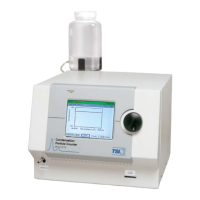Maintenance and Service 8-17
there is sufficient vacuum pressure even when the orifice itself is
clogged because the vacuum pump may pull less air flow through
the sensor.
A plugged orifice is best determined by measuring the inlet flow
while the instrument is in the low flow operation mode. Inlet flow
measurement is made using a volumetric flowmeter capable of
accurately measuring 0.3 L/min flow. A “bubble meter” or a TSI
flowmeter is an accurate meter for this purpose. Connect the
flowmeter to the instrument inlet and operate the instrument in the
low flow operation mode. Orifice replacement or cleaning is not
necessary if your CPC flow rate is measured near the value
indicated on the Status screen, at about 0.3 L/min. If a low inlet
flow is observed using the flowmeter, maintenance of the orifice is
recommended.
Note: Low nozzle pressure can indicate other problems too, such as
plugged nozzle pressure tubing. This can occur if butanol
collects in the tubing. Butanol in the nozzle pressure tubing
may indicate a more serious flooding problem. Contact TSI
service personnel if this problem occurs. A leak in the pump
sampling tubing or diminished pump performance will also
cause reduced flow through the critical flow orifice and
lowered nozzle pressure. This will be accompanied by a
reduced orifice pressure as well as nozzle pressure reduction.
Reference the discussion in Chapter 5, “
Technical Description,”
on critical flow for a better understanding of CPC flow.
To remove the critical orifice for cleaning or replacement, use the
following instructions:
1. Read warnings and cautions at the beginning of this chapter.
2. Unplug the instrument and remove the instrument cover by
loosening the six side panel screws (they don’t have to be fully
removed). Lift the cover up. Do not remove the screws holding
the clear butanol reservoir cover.
3. Identify the stainless steel barbed orifice fitting from
Figure 8-11 indicated by the arrow.
4. When performing any operations within the cabinet, take great
care to avoid stressing any electrical wiring. Damage to the
wiring may necessitate the return of the instrument to the
factory for repair.
5. Carefully separate the clear tubing from the orifice barb, prying
carefully between the end of the tube and fitting with a flat
blade screwdriver to facilitate tubing removal.
6. Use a
7
⁄16” socket wrench or nut driver to remove the fitting.
7. Clean or replace the orifice fitting. Cleaning may require the use
of an ultrasonic bath or use of appropriate solvent depending

